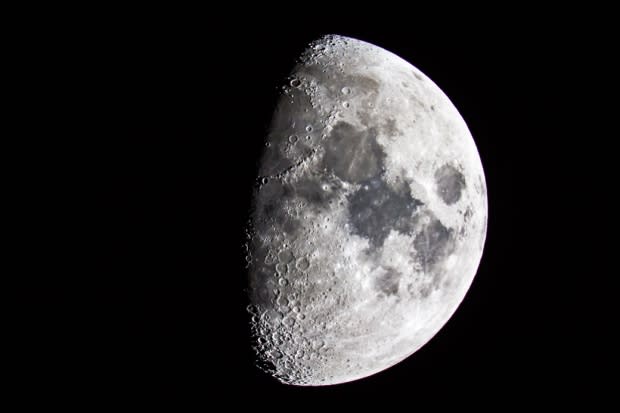Look up, way up! It's International Observe the Moon Night Saturday
Though it's our nearest celestial neighbour, we take the moon for granted. However, this weekend, you're encouraged to bundle up, step outside and look up for International Observe the Moon Night.
The international event was first held in 2010, following a national one in the U.S. a year earlier, in an effort to educate the public about lunar missions and about the moon in general.
That year, there were 278 moon-watching events in 40 countries. This year there are more than 800 events and participants worldwide, including, of course, in Canada.
While you can simply go out, look up at the moon and enjoy it, you can do more.
Watch a NASA visualization that attempts to capture the mood of Claude Debussy's Clair de Lune.
In Charlottetown, people are invited to join astronomers from the University of Prince Edward Island's department of physics. The public will get to look through a telescope, weather permitting, see the moon in exquisite detail and learn about our neighbour.
The Royal Astronomical Society of Canada will be hosting an event in Moncton, N.B., at the Moncton High School observatory, weather permitting. Amateur astronomers will set up their telescopes near the observatory for the public to enjoy a close-up view of the moon.
There are also events at St. Francis Xavier University in Antigonish, N.S., Western University in London, Ont., and at the David Dunlap Observatory north of Toronto, where there is a wait list to attend.
Check universities and astronomical groups for events near you.
But if there isn't an event near you, create your own. Just grab a pair of binoculars and head outside. This will give you a supremely special view: instead of the moon looking two-dimensional and unexceptional, you will see shadows extending over craters and ridges of mountains. You'll get a real sense that our companion is a rich three-dimensional world of its own.
Be warned, though: it's bright!
The moon will be past first quarter, as it's heading to a full moon on Oct. 24. This is actually a great time to explore it, as the terminator — the line that defines the bright and dark parts of the moon — will reveal the ridges of the hills and mountains.

Here are a few facts about the moon you may not have known:
It is the fifth-largest moon in our solar system, with a radius of 1,737.5 kilometres.
The average distance to the moon from Earth is 384,400 kilometres.
The moon is slowly moving away from Earth by about 2.5 centimetres annually.
The reason we see only one face of the moon is that it is tidally locked: the moon takes roughly 27 days to orbit Earth and it rotates on its axis at the same rate.
It's believed the moon formed after a Mars-sized body collided with Earth 4.5 billion years ago.
The moon has a very thin atmosphere called an exosphere.
Only 12 people have walked on the moon.
The dark regions are called maria (Latin for seas); they were filled with lava between 4.2 and 1.2 billion years ago.
It is responsible for creating our tides.
If you get clouded out, you can always watch the moon over Rome, hosted by The Virtual Telescope Project.
And if you'd like to take a super close-up view you can explore using NASA's Lunar Reconnaissance Orbiter map that allows you to zoom in as close as 0.5 metres a pixel.
As a bonus, this weekend is also the peak of the Orionid meteor shower, a result of Earth plowing through debris left over from Halley's comet. However, the bright moon — it will be roughly 85 per cent illuminated — will allow viewers to spot only the brightest meteors. Still, if you have a clear sky and a dark location, look southeast after midnight on the night of Oct. 21–22 for some shooting stars.
Though it's not a spectacular shower — the average for dark-sky location at its peak is about 25 meteors an hour — it can produce an outburst of more.
Watch an interactive map that shows the path of Halley's comet and the debris it shed.

